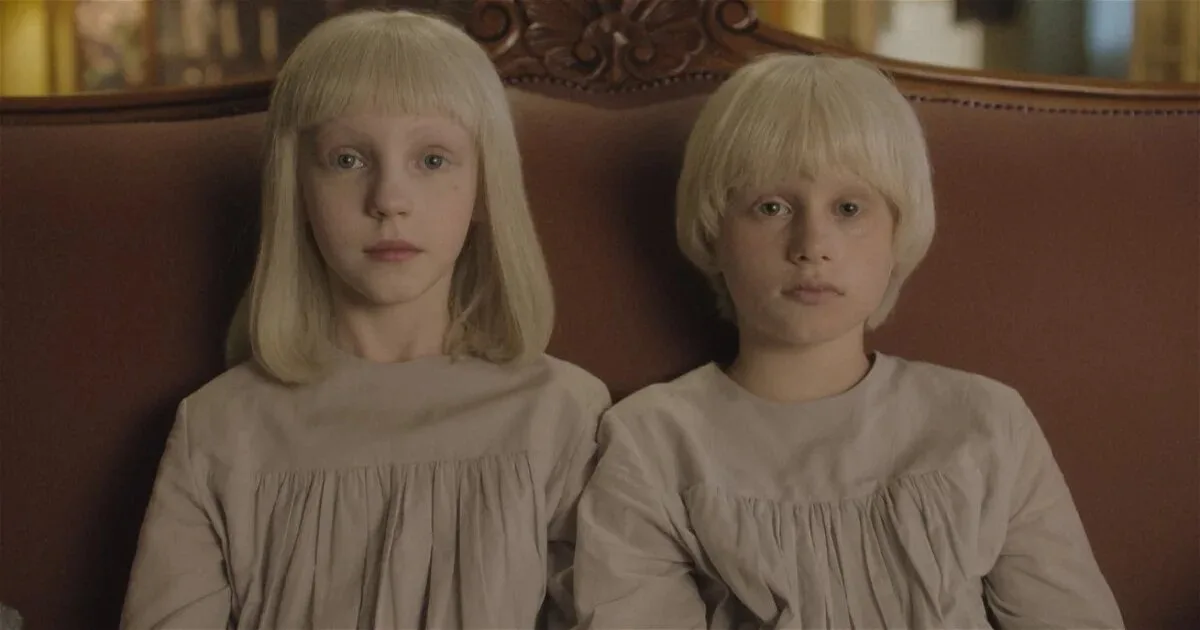Tin and Tina, For the Other Type of Horror Fan
Tin and Tina is a Spanish language horror film. It follows a woman who adopts two albino siblings from a convent who want to show her the light.
#netflix #motherofmovies #tin&tina

Streaming on Netflix, Tin and Tina was recommended by a friend of mine. As well as being inherently strange and at times bordering on absurd, it’s worth watching for a few reasons.
First, two creepy kids follow the word of the bible closely. Secondly, Tin and Tina are like the same Wish version of a Yorgos film, and finally, I’ve already watched it twice and noticed different things each time.
Tin and Tina are albino orphan twins with amazing musical talents, left to grow up in a convent under the strict guidance of nuns. Their religious beliefs are obsessively processed through the eyes of their childish and secularly socialised selves. Imagine taking the bible literally, but spending your formative years in a convent as well.
Written and directed by Ruben Stein, it’s a feature film directorial debut and, the title isn’t faring very well in the ratings.
Amongst complaints are notes about its ludicrous scenarios. Without watching it through satire-tinted glasses, Tin and Tina will feel like a massive waste of Netflix and Chill.
The creepy twins come on strong with their belief system and oddly twisted behavior. They instantly overtly play dangerous games like it’s a normal thing to do. In one scene, Lola is manipulated into watching them “See God,” which involves a plastic bag over Tin’s head. When he’s on the verge of passing out, the game is a success.
How to Spot a Controlling Man
The story of Tin and Tina follows Adolfo and Lola. Their wedding before the twins is a grand affair at a spectacular classic church with dozens of friends and family who we never see again.
Lola is pregnant but not yet showing. This is good news to Adolfo because in the first five minutes of the run time, Adolfo isn’t telling his wife she is the love of his life; he is talking about what a great mom she will be as they prepare to walk down the aisle.
She loses her babies, and we quickly get immersed in the couple’s toxic dynamic. Adolfo is a determined and assertive pilot who communicates his desire to fill his childhood home with children, despite his wife’s ongoing grief.
Lola’s character arc journeys through her ability to overcome the way she sees herself.
The title sets its characters up and pigeonholes them into submission. Adolfo is the absent husband and father who would rather watch sports than maintain supervision while his children swim in the pool.
Lola is a person with a disability who was impacted when escaping from a fire. She’s different, so she has poor self-confidence and doesn’t know how to stick up for herself.
Additional criticism surrounding the strange Netflix horror movie concerns the most used movie trope, the dolt decision-making complex. Between the controlling relationship, her miscarriage, and adopting freaky children, they sure do put up with a lot before they decide to throw in the towel.
Stein showcases confident simplicity in his characterisations, effectively conveying the messages in his themes.
Signs from God
Lola’s emotions are subtly yet powerfully revealed, such as the moment before she departs for the convent. She is depicted watching cartoons on television, which quote these words;
“If you’re feeling sad and lonely, don’t worry it will soon be over”
Lola disrupts Aldolfo’s undeserved reality by choosing albino twins, as she empathizes with being different. She is also acutely aware that Adolfo desires a perfect set of babies and has the financial means to achieve it.
When she discovers the twins in the church, Adolfo hadn’t even thought of his wife, and the nun had to ask her name to introduce Tin and Tina to her. She was both a factor in his process.
Even though this wasn’t the life she had envisioned for herself, she made an effort to find some element of choice and agency in the situation.
She goes along with conditional acceptance of adopting and chooses those two children not only because it’s the opposite of Adolfos’ choice, but because she feels a connection with them.
All four instantly assume their assigned roles, telling Tin and Tina to call them mommy and daddy. On their first night home, it becomes clear religion is a big part of who they are.
They make their new parents hang crucifixes from their creepy box full of religious trinkets, the twins use to keep the exterminator out.
Cementing their status as a family, they begin to work through the kinks like any family would.
The worse things get for Lola, the more she can see that her needs aren’t met. Despite their increasingly sinister acts, Lola slowly realises how irrelevant she is to Adolfo.
The Tin and Tina film commits plenty of movie crimes. But as a satire, it works well. I watched it in dubbed, which made it funny at times.
Hidden Movie Gem | Tin and Tina
The two children encapsulate the type of belief systems that might manifest if taking the bible at its most literal. It’s also a great concept in an interesting dynamic.
The point is that Tin and Tina’s beliefs led to “miracles.” Even if those miracles could be chalked up to coincidence. The intensity of the children’s acts confuses what is good and what is evil.
Imagine They Are Evil Twins
They asked God to get adopted and for Lola to have another baby. Popping “miracles” left and right and for who knows how long before. Their wishes keep coming true.
They apply their own understanding to the Bibles words, and it’s carried them here so far.
Sure, they killed her dog and made a habit of trying to make each other pass out on the regular, but nobody said religion was straightforward. It’s easily misunderstood. Or is it?
For them, God’s wrath is just a repercussion of doing awful things. And if not Gods wrath, penance will get them out of Hells waiting room. Simple.
Steins’ ode to all things biblical under the rules of God could be seen as a rhetorical look into what faith means for different people.
As a setting for the story, alongside how ambiguous Tin and Tina are as suspects, the movie is what I would consider an underrated hidden movie gem.
Worthy of a second watch, the film has plenty to ponder in its predictable and often unbelievable ventures. But it’s interesting, different, and has way more depth than it’s been given credit for.
Watch the trailer for Tin Ve Tina on YouTube here

Did Tin and Tina Do It?
Tin and Tina have solid alibis for the more serious crimes, such as Pedro’s death. Adolfo accurately pointed out that the drawing was likely a result of persistent bullying. They watched Dracula without understanding its themes and believed Kuki would be resurrected. Although it seemed like Lola was being poisoned due to the previous incident with bug powder, there is no evidence that Tina put anything harmful in Lola’s milk. After all, she was only tied up with Christmas tinsel. Regarding the baby baptism, their use of the Bible for instruction may have broken some rules, but it ensured they knew what to do.
Just watch it and decide for yourself. This title can also be viewed from the angle that Tin and Tina are evil beings knowingly persecuting people by signaling under the words of God.
Was it really a deer on the road that night?
For another religious-themed horror movie, watch Glorious, Welcome to Mercy, Prey, Terrified, or Shaitaan next.
Tin and Tina film is rated
3.5 evil twins out of 5
The ending of Tin and Tina
Why did Lola return to the convent and pick up the twins? Adolfo was struck by lightning, which reinforced Tin and Tina’s beliefs. She confidently put a pillowcase over her head to ask God for help in finding her baby. When she found it, her faith was restored, and she knew they were innocent of everything she had suspected.
Tin and Tina, For the Other Type of Horror Fan

Director: Ruben Stein
Date Created: 2023-03-28 17:04
3.75
